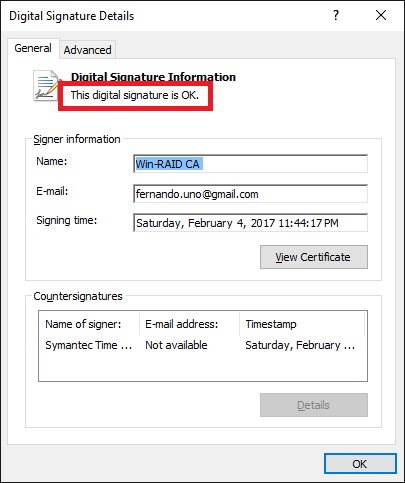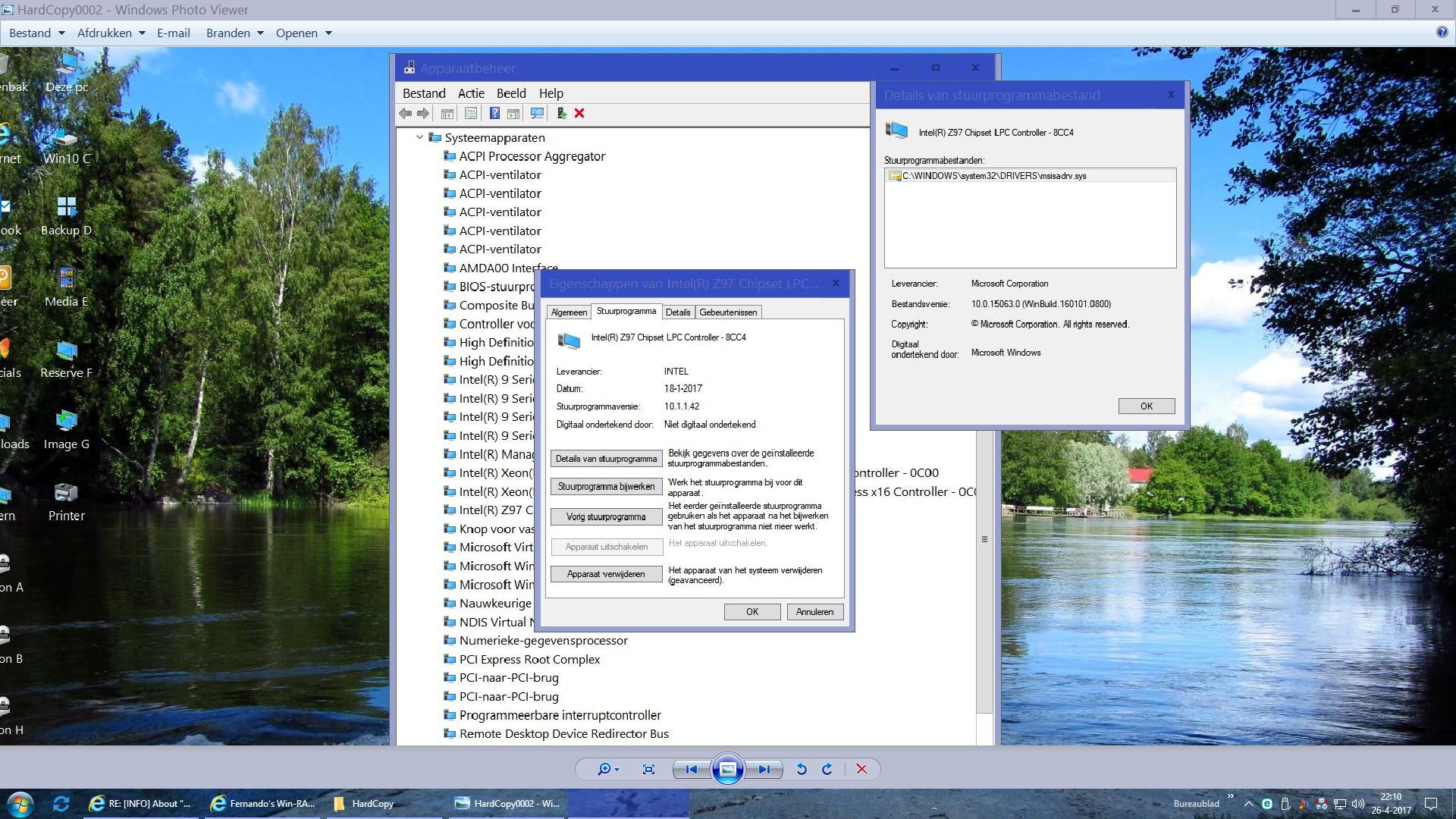It works even with the currently latest Win10 Build 16179, which I am running now.
I suspect, that it is the upgrade, which may be responsable for your "problem", which is not really one, because you obviously were able to successfully update the Intel Chipset Device INF files by using my mod+signed variants.
Remember: There is no difference regarding the functionality and stability between a modded and a digitally signed driver!
" There is no difference regarding the functionality and stability between a modded and a digitally signed driver! "…very good to know !!
@Pete12 :
That the digital signature of my modded INF files is accepted by Windows, can be easily verified by
a) doing a right-click onto any of the *.CAT files, which are associated to the *.INF files,
b) choosing the option "Properties",
c) choosing the tab "Digital Signatures",
d) clicking onto "Win-RAID CA" and
e) hitting the button "Details".
It should look like this:

Yes, you are right indeed, just checked the folder with the driver-files,they are all “digital signed” , remains the question why we can not see this in the device-manager, all these drivers are " not signed" , and on other tab of the properties they are signed by Microsoft !

Do we see this only when using Powershell for inserting the certificate ?
No, this has nothing to do with the procedure of the Certficate import.
Since the same mod+signed drivers are shown on my system (OS freshly installed) as digitally signed, I suspect, that it has something to do with the fact, that you had updated your Win10 v1607, which had already used my mod+signed drivers, to v1703 with the consequence, that the Intel Chipset Device INF files were overwritten by the older, but "better" WHQL certified files.
As I already have written: It doesn’t matter whether a "driver" (in this case it is just a text file) is shown for the user as being digitally signed or not. The only important thing is, that the "driver" has been successfully installed and works properly.
Hello
I am aware the driver didn’t install and updated the installer accordingly - please re download to get the fixed copy.
EDIT by Fernando: Added link removed, because it is not topic related
To whom did you address this tip?
Thanks for the detailed tutorial.
As far as I know Windows 8+ versions already contain USB 3.0 drivers for Intel’s hardware and you don’t need to install anything else to get your devices working.
Do you know any specific advantages of this method, or do you perhaps have some interesting benchmark results? I didn’t test it myself, I’m just curious.
@adsvoo :
Yes, Win8 and Win10 do contain generic MS USB 3.0/3.1 drivers, which do support Intel USB 3.0/3.1 Controllers and Hub devices as well, but according to the report of many users the Intel USB 3.0/3.1 drivers have a much better performance.
That is why I offer mod+signed variants of the latest Intel USB 3.0/3.1 drivers, which natively only do support Win7, by adding the compatibility with Win8/8.1/10.
You can test it yourself, which drivers are the best for your specific system.
Regards
Dieter (alias Fernando)
Is there a tool like .INF editor which can help to modify .INF files?
@cjkm646 Welcome to the Win-Raid Forum!
The *.INF files are simple text files and can be opened and modified by any text editor like the Windows notepad.exe.
Note: Any modification of the .INF file will destroy the digital signature of the related driver (.SYS file).
Good luck!
Dieter (alias Fernando)
I know all that. The contents of .INF files are subject to strict rules. Modifying an .INF file in an attempt to misuse a driver is a very difficult task to satisfy those rules. Something formally similar was done by the BCD Store editors.
I asked if there was a program that would make it easier to modify .INF files because of the constant need for Windows 7 drivers.
As far as the signature is concerned - in my opinion it is much easier than modifying an .INF file:)
I don’t know a tool, which is able to customize an *.inf file, but according to my own experiences with modded drivers it is very easy to add missing HardwareIDs of certain Controllers or to add the support of a certain Windows OS.
But: These *.inf file modifications don’t have any effect, if the driver itself (the *.sys file) doesn’t support the related device or OS.
That’s exactly what I’d like to discuss with you, if you’ll allow me. I was trying to find information about the real difference between w7 and w10 drivers, I mean the difference in the .sys files. Which would not allow the .sys files of w10 to be used in w7. But no luck. Do you know something regarding this issue?
I cannot help you, because I have never modified a *.sys file (and will never try to do it).
Hi. I just discovered this forum today. I’m looking to build a new computer, as mine is already old, but I want Windows 7 only.
From what I understood of the text, I only need to change the INF file. So I downloaded one from the Gigabyte website, for the B560M Aorus Elite.
Got this in the file:
[Version]
Signature=$WINDOWS NT$
Class=System
ClassGUID={4D36E97D-E325-11CE-BFC1-08002BE10318}
Provider=%INTEL%
CatalogFile=RocketLake.cat
DriverVer=07/18/1968, 10.1.41.5
PnpLockDown=1[SourceDisksNames]
[SourceDisksFiles]
[ControlFlags]
ExcludeFromSelect=*[Manufacturer]
%INTEL%=INTEL,NTx86,NTamd64[INTEL.NTx86]
%PCI\VEN_8086&DEV_4C63Desc%=Needs_NO_DRV,PCI\VEN_8086&DEV_4C63
%PCI\VEN_8086&DEV_4C53Desc%=Needs_NO_DRV,PCI\VEN_8086&DEV_4C53
%PCI\VEN_8086&DEV_4C43Desc%=Needs_NO_DRV,PCI\VEN_8086&DEV_4C43
%PCI\VEN_8086&DEV_4C33Desc%=Needs_NO_DRV,PCI\VEN_8086&DEV_4C33
%PCI\VEN_8086&DEV_4C23Desc%=Needs_NO_DRV,PCI\VEN_8086&DEV_4C23
%PCI\VEN_8086&DEV_4C01Desc%=Needs_PCI_DRV,PCI\VEN_8086&DEV_4C01
%PCI\VEN_8086&DEV_4C03Desc%=Needs_NO_DRV,PCI\VEN_8086&DEV_4C03
%PCI\VEN_8086&DEV_4C05Desc%=Needs_PCI_DRV,PCI\VEN_8086&DEV_4C05
%PCI\VEN_8086&DEV_4C07Desc%=Needs_PCI_DRV,PCI\VEN_8086&DEV_4C07
%PCI\VEN_8086&DEV_4C09Desc%=Needs_PCI_DRV,PCI\VEN_8086&DEV_4C09
%PCI\VEN_8086&DEV_4C11Desc%=Needs_NO_DRV,PCI\VEN_8086&DEV_4C11
%PCI\VEN_8086&DEV_4C19Desc%=Needs_NO_DRV,PCI\VEN_8086&DEV_4C19[INTEL.NTamd64]
%PCI\VEN_8086&DEV_4C63Desc%=Needs_NO_DRV,PCI\VEN_8086&DEV_4C63
%PCI\VEN_8086&DEV_4C53Desc%=Needs_NO_DRV,PCI\VEN_8086&DEV_4C53
%PCI\VEN_8086&DEV_4C43Desc%=Needs_NO_DRV,PCI\VEN_8086&DEV_4C43
%PCI\VEN_8086&DEV_4C33Desc%=Needs_NO_DRV,PCI\VEN_8086&DEV_4C33
%PCI\VEN_8086&DEV_4C23Desc%=Needs_NO_DRV,PCI\VEN_8086&DEV_4C23
%PCI\VEN_8086&DEV_4C01Desc%=Needs_PCI_DRV,PCI\VEN_8086&DEV_4C01
%PCI\VEN_8086&DEV_4C03Desc%=Needs_NO_DRV,PCI\VEN_8086&DEV_4C03
%PCI\VEN_8086&DEV_4C05Desc%=Needs_PCI_DRV,PCI\VEN_8086&DEV_4C05
%PCI\VEN_8086&DEV_4C07Desc%=Needs_PCI_DRV,PCI\VEN_8086&DEV_4C07
%PCI\VEN_8086&DEV_4C09Desc%=Needs_PCI_DRV,PCI\VEN_8086&DEV_4C09
%PCI\VEN_8086&DEV_4C11Desc%=Needs_NO_DRV,PCI\VEN_8086&DEV_4C11
%PCI\VEN_8086&DEV_4C19Desc%=Needs_NO_DRV,PCI\VEN_8086&DEV_4C19[Needs_NO_DRV]
Include=machine.inf
Needs=NO_DRV[Needs_NO_DRV.Services]
Include=machine.inf
Needs=NO_DRV.Services[Needs_PCI_DRV]
Include=machine.inf
Needs=PCI_DRV[Needs_PCI_DRV.Services]
Include=machine.inf
Needs=PCI_DRV.Services[Needs_PCI_DRV.HW]
Include=machine.inf
Needs=PCI_DRV.HW[Strings]
INTEL=“INTEL”
PCI\VEN_8086&DEV_4C63Desc=“Intel(R) Host Bridge/DRAM Registers - 4C63”
PCI\VEN_8086&DEV_4C53Desc=“Intel(R) Host Bridge/DRAM Registers - 4C53”
PCI\VEN_8086&DEV_4C43Desc=“Intel(R) Host Bridge/DRAM Registers - 4C43”
PCI\VEN_8086&DEV_4C33Desc=“Intel(R) Host Bridge/DRAM Registers - 4C33”
PCI\VEN_8086&DEV_4C23Desc=“Intel(R) Host Bridge/DRAM Registers - 4C23”
PCI\VEN_8086&DEV_4C01Desc=“Intel(R) PEG10 - 4C01”
PCI\VEN_8086&DEV_4C03Desc=“Intel(R) Camarillo Device - 4C03”
PCI\VEN_8086&DEV_4C05Desc=“Intel(R) PEG11 - 4C05”
PCI\VEN_8086&DEV_4C07Desc=“Intel(R) PEG12 - 4C07”
PCI\VEN_8086&DEV_4C09Desc=“Intel(R) PEG60 - 4C09”
PCI\VEN_8086&DEV_4C11Desc=“Intel(R) GNA - 4C11”
PCI\VEN_8086&DEV_4C19Desc=“Intel(R) NPK - 4C19”
Do I just need to change the signature? Is that it? Then download all the other packages in the Gigabyte website?
What do I put in the signature? Windows 7? It is written Windows NT.
Also if anyone have a Gigabyte LGA1200 motherboard, please report.
@Wolfstorm
Welcome to the Win-Raid Forum!
The sense and the location of your request is not easy to understand.
-
There is no need to give the Intel Chipset Device INF file named RocketLakeSystem.inf a digital signature, because its associated file named rocketlake.cat contains it already.
By the way - the Intel Chipset Device INF files do not contain any real driver (= *.SYS file) and are not required at all for the proper installation and function of any Windows OS. For details please read the start post of >this< thread. -
Users, who are searching for a specific driver, which supports an outdated OS like Win7, should post their request into >this< buch better matching Forum Category and add at least the following information:
a) name and chipset of your mainboard/system
b) details about the Windows OS you are running or want to install incl. its architecture (32/64bit)
c) sort and name of the related device (best choice: its HardwareIDs)
Good luck!
Dieter (alias Fernando)